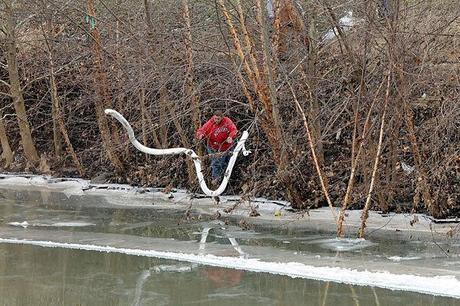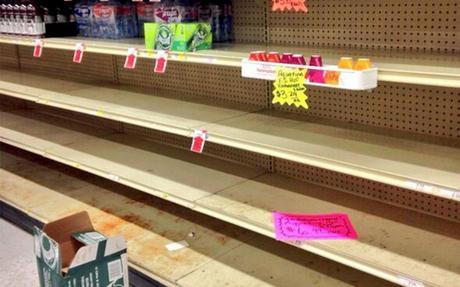
A Freedom Industries worker places boom in the Elk River at the site of the chemical spill
by Trish Kahle / I Can’t Believe We Still Have to Protest this Shit
This is Part 1 of a 2 Part series that will examine the political and social ramifications of the chemical spill in West Virginia and the history of Appalachian struggle against human and ecological destruction. Part 1 will focus on the spill and its aftermath. Part 2 will put this disaster in historical context and discuss what the legacy of ecological and class warfare in central Appalachia can teach ecosocialists today.
Imagine living in the rugged countryside of the Appalachian mountains. You have no source of income or means of transportation, and you find your water has been poisoned and cannot be used–even after being boiled–until further notice. Imagine trying to run a hospital when none of the city’s water can be used–even for hand-washing. Imagine having to ration drinking water to school age children in the fourth most water-rich country on earth.
All of these stories and more came true in West Virginia on January 9, after residents reported water that tasted like licorice. The contamination turned out to be 4-methylcyclohexane methanol, a chemical used to produce the misleadingly named “clean coal” through the froth flotation process which “scrubs” the coal prior to burning in power plants.
As of this writing, an unknown amount of the substance had spilled from a 48,000 gallon container located along the Elk River, owned by Freedom Industries (FI). Despite being located only one mile upstream from the water treatment plant where drinking water was contaminated, Tom Aluise of the West Virginia Environmental Protection Association noted that the chemical cannot actually be removed from the water–and residents will simply have to wait for more than 60 miles of pipelines to be completely flushed before water safety can be reassessed. “This material pretty much floats on the water, and it’s floating downstream, and eventually it will dissipate, but you can’t actually get in there and remove it,” Aluise said.FI claims they don’t know how the hole which caused the toxic substance to leak into the containment area and then into the river got there, but then, according to its own website, FI keeps maintains bulk quantities of not only 4-methylcyclohexane methanol, but 5 other flotation reagents–not to mention the other products stored on site, which include other specialty chemicals including freeze conditioning agents (used in deicing), dust control palliatives, water treatment polymers, and other mining chemicals. ”With 4,000,000 gallons of storage capacity,” boasts the Freedom Industries website, the Elk River terminal “can process large volumes of chemical rapidly, and cost effectively.” Processing them safely, on the other hand, doesn’t seem to be a primary concern.
Although air-quality officials began receiving odor reports about the facility as early as 7:30 a.m., the emergency response chief of the Department of Environmental Protection didn’t receive word of the spill until noon. The Charleston Gazette reported that the company had failed to report the spill to the self-regulation agencies, which raises the question why a chemical corporation more interested in efficiency than the safety of hundreds of thousands of people is allowed to regulate itself anyway. A search of the Environmental Protection Agency’s facility compliance reports found no record of inspections at the facility for available years, presenting a striking parallel with low OSHA inspection rates that resulted in a deadly explosion at a Texas fertilizer plant last year.
And, of course, with no way for the chemical to be removed from the water through a clean-up operation, it remains unclear what the short and long term effects will be beyond contaminating the water supply of the Kanawha Valley, West Virginia’s most populated region. The materials safety data sheets, compiled by OSHA, lists little information about the effects of the chemical, and many emergency officials say they know little about the potential effects of the chemical. West Virginia American Water President Jeff McIntyre did little to reassure residents when he refused to get specific about possible effects, only saying that “it’s not particularly lethal in its usage form.” And while not completely sure how the contamination will affect residents, the West Virginia Department of Health and Human Resources said that possible effects of ingestion or inhalation could include “severe burning in throat, severe eye irritation, non-stop vomiting, trouble breathing or severe skin irritation such as skin blistering.”

Empty shelves at a Charleston area store.
In addition to the human effects, it’s not clear what the ecological consequences of the spill will be. The Elk River is a major tributary of the Ohio River, and the Appalachian mountains–as well as the valleys downstream–are home to ecosystems already under threat from more than a century of burning coal, mountain-top removal, strip mining, deforestation, and more. Many people rely on these rivers for water supplies, irrigation, and leisure.
Meanwhile, hundreds of thousands of people are without water in one of the poorest rural areas of the country, and the government has no idea when the water will be safe to drink again. The emergency response has been entirely inadequate, leaving those who could afford it–and who had transportation to get to a store–scrambling to buy rapidly disappearing supplies of bottled water. The Health Department closed all restaurants, tattoo parlors, and schools, and many businesses will remain closed.
Nursing homes and hospitals, while also under the advisory, must still struggle to provide basic services. According to the Charleston Gazette, however, some nursing homes will shut down, leaving elderly and disabled people without vital access to care at a critical time. The Charleston Area Medical Center has canceled all procedures until the water use ban is lifted.
West Virginians were quick to point out on social media the failure of the government and the water company in warning people about the danger. As Teresa Boggs Meadow noted, “already cooked, ran the dishwasher, done laundry and drank it. If it happened so early why did you put the warning out so late? It happened at 10:30 AM!”
Soon after the announcement, stores began to run out of water supplies. Residents tweeted out that stores were gouging prices, trying to make some extra money from people’s fear. As of Thursday evening, the state had asked for help in acquiring and distributing more bottled water from FEMA.
Yet no amount of feigned concern from state and national officials can cover how badly the situation has been handled. Once again, the companies have engaged in ecological warfare against the people of the Appalachian mountains. Once again, the state was negligent in the enforcement of regulations and colluded with company officials to assert control over the situation and avoid the companies being held meaningfully accountable for their actions. Once again, the lives of working people and the health of the land and resources they rely on have come second to the demands of capitalism. The latest spill in the Elk River is the latest chapter in a long story of ecological and class warfare, where the coal companies have attempted to crush the working people, rob them of their land, and devastate the ecosystems they rely on for survival. It’s a story that is far too familiar to the people of West Virginia. As Marilyn Mullens of Cool Ridge W.Va. noted:
“Just for the world to know. This is the same chemical they use to “clean the coal.” The same chemical that is pumped into billion gallon earthen dams that litter the Appalachian mountains. The chemicals have been seeping into the streams and groundwater of coal field residents for years. Some of us have been pleading with our elected officials to stop this but they are paid off by the coal companies. The same coal companies that are on record as saying my people are “collateral damage” and “expendable.” Now this chemical spills into their drinking water and they tuck tail and run. Go figure.”
So-called “Clean Coal” is a dangerous myth. It can be easy, sometimes, for those of us who don’t live in coal producing areas of the country, to forget the social and ecological toll coal burning and production takes on land and people. For the most part, away from smokestacks and slurry dams, we can forget that at the other end of the energy production chain, all the ugliness is still there. People often claim sustainable energy alternatives–solar panels and wind turbines, for example–are a blight on the landscape. Not only is this untrue, but it ignores the real blight–the one we have outsourced (or perhaps, insourced) to the Appalachian coalfields and imposed on the people who live there, impoverished and murdered by the same energy companies who are destroying the entire planet.
—
It’s no coincidence that this happened in one of the poorest areas of the country. In fact, the same companies that poison the water, decimate the mountaintops, and erect dams to hold back unfathomable amounts of “mountain slurry” are also responsible for the high levels of poverty that exist throughout the region. For more than a century, minimizing access to health care, education, and other social services has helped employers extract as much profit as possible from the region by keeping corporate tax rates low and by not requiring corporations who own operations in the state to even pay taxes there in the first place. It is in this context we must comprehend the utter failures of state departments to respond to the chemical spill crisis.
What should have been the alternative to leaving those who were able scrambling to find water supplies? How could hospitals and other medical facilities been prioritized to receive water so the most vulnerable among us would be in less danger?
Instead of closing the schools and other public buildings, these facilities should have been opened to the public as emergency relief centers. Available water supplies should have been centralized, assessed, and distributed according to need, with special attention to vulnerable populations. Communication check-ins should have been established to make sure people in more remote areas got the message to discontinue use of the water, and to make sure those people had adequate supplies on hand.
Instead, the people of West Virginia have been left, for the most part, to fend for themselves. Even as we organize to send them what aid we can to get them through the crisis, the need for a systemic change has never been more urgent. Capitalism is killing us, and our planet. In the grand ways–the super storms, extended fire seasons, rising ocean temperatures, and skyrocketing extinction rates–yes. But also in small ways, a river here, a person there. A person who could have been part of helping build a solution.

